This is a page within the www.staffshomeguard.co.uk website. To see full contents, go to SITE MAP.
HOME GUARD MEMORIES AND INFORMATION
: COUNTIES T-Z - YORKSHIRE
25th WEST
RIDING (HUDDERSFIELD) BATTN.
and
CAPTAIN ERIC SELBY |
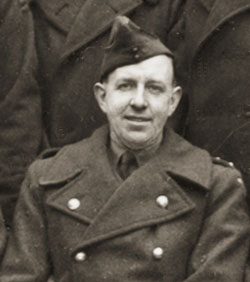 The
25th West Riding
(Huddersfield) Battalion was responsible,
together with the 26th
West Riding, for the
town of Huddersfield
and its immediately adjoining area. It was commanded
in 1944 and probably throughout its life by
Lt.-Col. P. Moxon, T.D. One of its
other officers was Captain Eric
Lawrence Francis Selby
(1896-1970, shown
right). The
25th West Riding
(Huddersfield) Battalion was responsible,
together with the 26th
West Riding, for the
town of Huddersfield
and its immediately adjoining area. It was commanded
in 1944 and probably throughout its life by
Lt.-Col. P. Moxon, T.D. One of its
other officers was Captain Eric
Lawrence Francis Selby
(1896-1970, shown
right).
This
page contains images of all the Battalion officers
and of one of its constituent Companies of which
there will have been several, responsible either for
a particular geographical area within the Battalion
territory and broken down into platoons; or, as is
the case here, for a number of specialised
Battalion-wide functions including administration,
intelligence, stores, equipment and weaponry,
signalling, training etc. - the HQ Company.
The
date and location of the images is unknown. But they
are clearly taken at the same place and very
probably on the same occasion. It is a wintery day.
The officers have foresaken their greatcoats - but
not their gloves; whereas in the other photograph
everyone has been chosen prudence over photogeneity
and retained their warm outer clothing! One can
speculate on the date. Many photographs of this type
were taken on the occasion on an anniversary of the
creation of the Home Guard - in May each year.
Sometimes the Battalion assembled for a particularly
significant parade - in support of Wings for Victory
Week for example. And of course the occasion of the
stand-down of the Home Guard in December 1944. It is
almost certain that the latter is the
reason for these and no doubt similar, still to
surface, images of the 25th West Riding and this is
reinforced by the caption for these prints, once the
property of Eric Selby, which states "December
1944". And so we can fairly safely assume that the
men were photographed on the morning of Sunday 3rd
December 1944, just before embarking on a large
ceremonial parade through the middle of Huddersfield
before applauding crowds. The weather on that morning
was relatively mild but very windy with rain. The
boots would have soon lost their wonderful shine but
that would have been a minor consideration when later
that day, possibly fortified by a pint or two, they
said their farewells to their comrades, returned home to their families and hung up their
uniform for the very last time.
Again
we can only speculate on the location. We are in the
shadow of a large industrial building - a mill or
factory perhaps. It may have hosted the Battalion
and contained the latter's Battalion H.Q. It has
been suggested that the buildings stand in the
Oakes or
Lindley area of
Huddersfield.
This first image below shows a group comprising all or most of the
Battalion officers. Captain
Eric Selby is located 7th from the left in the
second row.
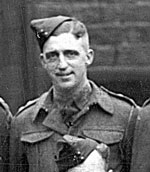 |
In this group
photograph a further officer has been
identified: Lt.
S. Garrard
(left).
He is standing 7th from the left in the back
row. Like Capt. Selby, Lt. Garrard was a
survivor of the Western Front where he had
served as a DonR (Despatch Rider) with the
rank of corporal
(right)
and
received his Home Guard commission some time
after February 1941.
In his private life he was the founder of a
successful local timber business. |
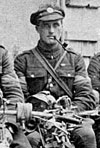 |
|

The image below shows the HQ Company within the
Battalion. Eric Selby is in the
front row, 8th from the
left and next to the Company Commander. He is a
senior member of this Company, perhaps even the 2
i/c.
|
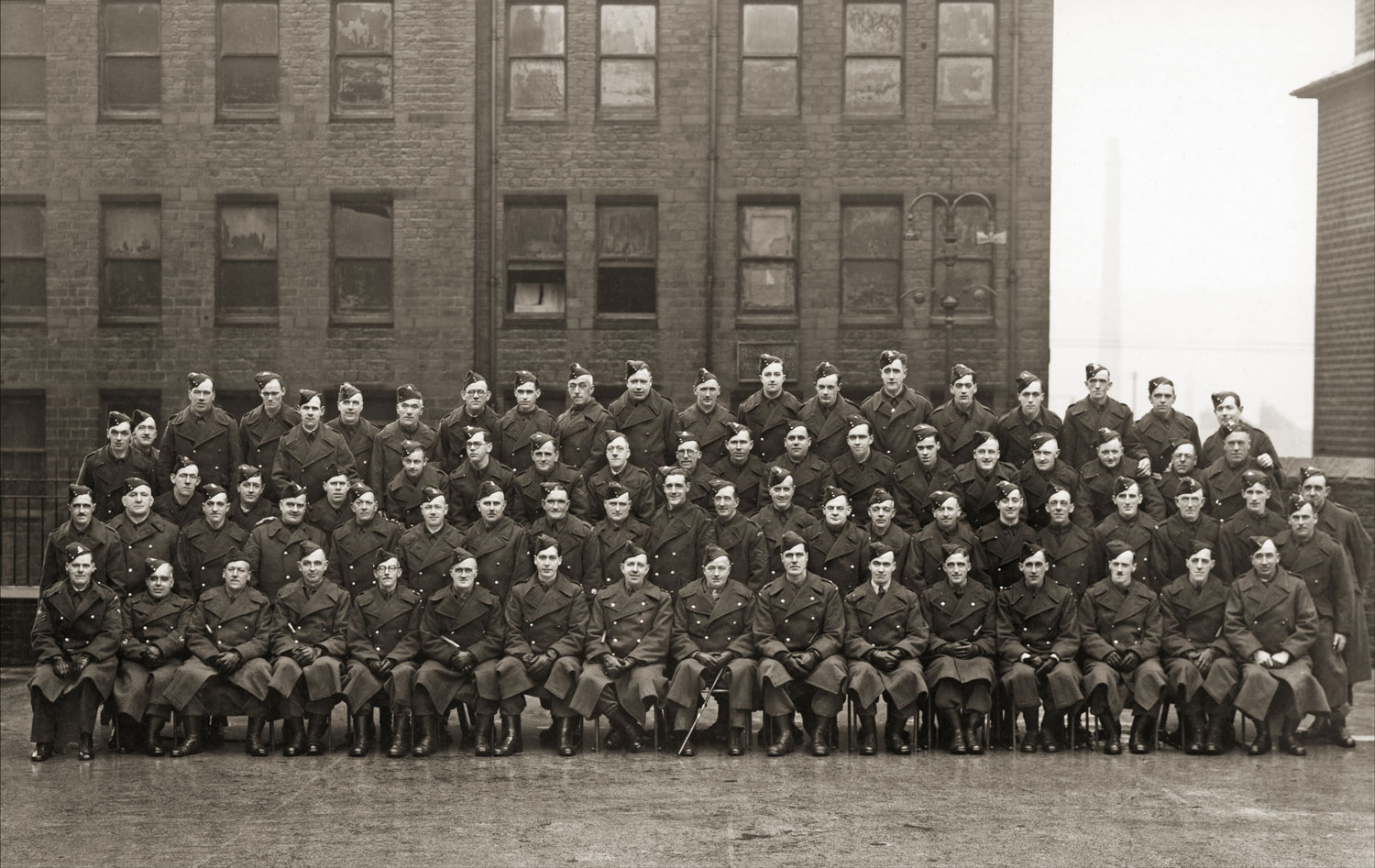
|
Eric
Selby's previous military history would have been
very relevant to his rank and important position in
the Company and Battalion. He was in the Army from
1915 to 1919, mainly in Palestine where he served as
quartermaster sergeant under
General Allenby.
We do not know his exact period of Home Guard
service but it is safe to assume that he was an
early volunteer some time after May 1940, that he
was immediately appointed to a position of authority
and that he served throughout.
Almost no information seems to have survived about
Eric's Home Guard service. Just the odd anecdotal
fragment, such as his occasionally benefiting from
the perks of the job: a precious pound of butter or
a few sugar lumps or even a whole bag of sugar. As
he is likely to have had some sort of quartermaster
responsibility, with a duty to justify everything to
the last halfpenny, these surpluses are certain to
have been 100% genuine! (Did he have to resort to
the desperate measure adopted by one of his comrades
in another unit, trying to explain the shortfall of
one bar of chocolate in his stores? A spark of true
inspiration: "Eaten by mice"). Otherwise no traces
remain of his devoted service over four-and-a-half
long years and several thousand hours of entirely
voluntary effort.
In
his private life, Eric spent much of his childhood
in Doncaster. After a move to Huddersfield he
joined the local accountancy firm of Armitage and Norton
in 1911 when he was fifteen, initially as an office
boy. He stopped there all his working life,
travelling in Germany each year of the 1930s on
behalf of the firm and taking with him on occasion
the young Mr. Norton; it was then, perhaps in 1937,
that they saw Hitler at the opera, together with his
associates.
He
married Mary Oldham
(d. 1958) in 1927.
They lived at
18 Macauley Road, Birkby,
Huddersfield,
the home of her parents. Eric never moved away
from there. Mary's parents built,
that same year,
'Glion', Marling Road,
Fixby, Huddersfield
(which was near to
Ainley Top).
Eric and Mary had two sons,
Roger
(1929-2013)
who was a G.P. in the area; and
Edward
(1933-2011)
who worked in the wool trade.
Eric
continued to live and work in Huddersfield for the
rest of his life, still at 18 Macauley Road and continuing to enjoy his pipe and a
dram of whisky as well as regular visits to the
Crosland Heath Golf Club
where he was a committee member in the 1960s.
He carried on working until 1968 when he retired at
the age of 72. Sadly his days of leisure were short:
he had a heart attack in 1969
and passed away suddenly on 6th February 1970.
| |
|
|
1920s
with his mother
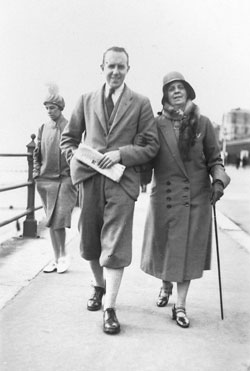 |
1930
with Mary and Roger
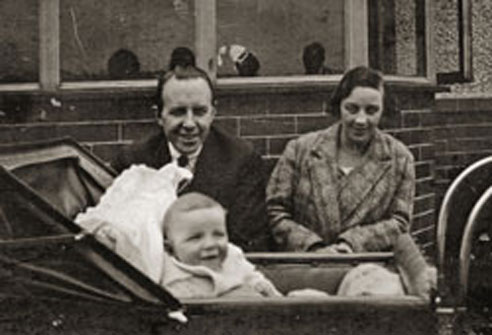 |
late 1930s
with Edward and Roger
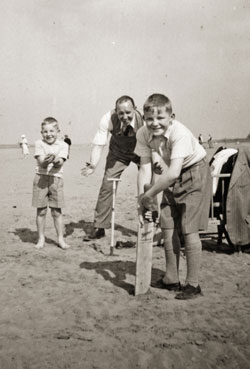 |
again,
late 1930s
with Roger and Edward
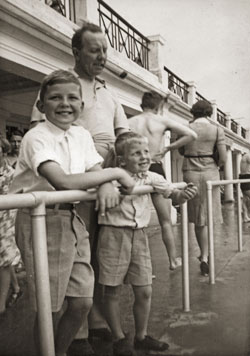 |
1944
in the Home Guard
 |
1950s
with Mary and Roger
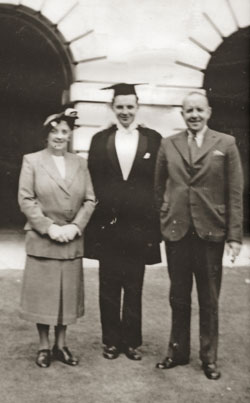 |
1952
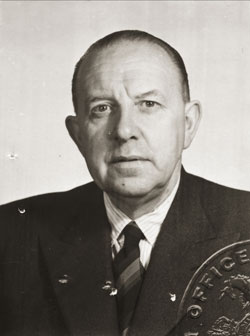 |
1960s
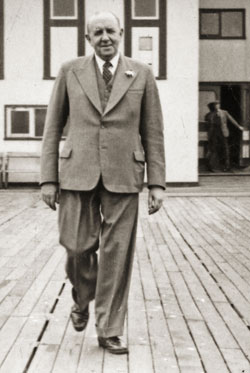 |
1962
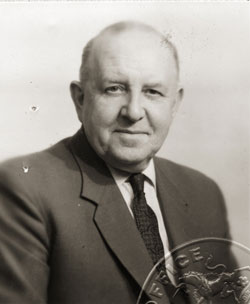 |
|
|
A NOTE ON THE HUDDERSFIELD HOME GUARD
BATTALIONS
The Huddersfield Home Guard comprised two
Battalions, the
25th and
the 26th West Riding (Huddersfield) Battalions.
They were just two of the 72 West Riding Home Guard
battalions responsible for every square-inch of the area
and each comprising perhaps 1000/1500 men.
Lt. J. W. Lockwood was Press Liaison Officer of the
26th West Riding Battalion (whose C.O. was
Lt.-Col. R. Rippon, T.D.)
Lt. Lockwood provides a glimpse of
the Huddersfield Home Guard activities in the first
half of the war and is quoted
in "The Home Guard of Britain" by Charles Graves
(Hutchinson & Co., 1943):
|
The story of
the Home Guard in Huddersfield and the Colne Valley
is similar to that in hundreds of other areas.
Guards, drills, lectures and demonstrations with
only a few incidents and excitements of a minor
character to break the usual routine. The
maintenance of a steady "dogged as does it"
enthusiasm over the entire period since Dunkirk
would seem to be the keynote. Shop, office,
engineering and textile workers, working long hours
in Huddersfield and the Colne Valley, have kept a
vigil on the wild Yorkshire Moors at night. To many
of them living in the valleys this meant an ascent
to well over 1000 feet where in winter the climate
often resembles the Arctic. Yet in spite of these
difficulties, guards were maintained throughout the
storms of two very severe winters. |
Writing specifically about the earliest days in the
26th but no doubt relevant to the 25th too:
With regard to the L.D.V. days our Battalion on
the whole was quickly and generally well housed. All
kinds of old equipment and uniforms appeared as if
by magic. Revolvers and shotguns were sufficient,
together with a few rifles, to supply the mighty
patrols over the moors. When denim appeared, I think
my company had 10 sets. This involved a rather
hurried change each time a patrol returned. The
results were often funny – a six-footer exchanging
garments with a former member of a Great War bantam
battalion.
It was not long before there was a
rebellion against this procedure and a reversion to
the armband as sole uniform was ordered. Another
feature of those days was the comforts fund,
subscribed mainly by the members themselves. This
fund acted as a supplement and a gap filler between
the hundred-and-one requirements and the prevailing
tardiness of the official orders authorising the
spending of money. Beds, blackout curtains, wireless
receivers, cooking utensils and food are a few of
the items. |
And he also quotes a story
from the 25th Battalion:
A report was
received to stop a certain War Office car, the
number of which was given. This car was stopped near
the Borough boundary. The civilian driving it became
so angry at being taken to the police station four
miles away that his guards used very forcible
methods and so thoroughly frightened him that, when
all was explained and his papers proving that he was
an Air Ministry official had been produced to the
police, he would not drive out of the Borough along
the same road without a safe conduct from the Group
Commander.
|
|
|
|
In memory of
Captain Eric Selby
of
The Huddersfield Home
Guard
and all his comrades
in the
25th
and 26th West Riding
(Huddersfield) Battalions,
Home Guard
|
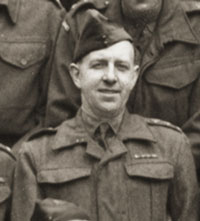 |
|
ACKNOWLEDGEMENT
Grateful acknowledgement is made to Richard Selby (and also to other family members
including
Sally and Nicholas Selby) for providing these group
photographs and the information about his grandfather; and for permitting
their publication
by staffshomeguard.
Similar acknowledgement is also made
to:
Martin Pegler
for information on Lt. Garrard
and
"The
Home Guard of Britain"
by Charles Graves
(1943, Hutchinson & Co.)
FURTHER
INFORMATION
For other Memories and Information relating to
Yorkshire units:
use these
"MEMORIES -
YORKSHIRE"
or
SEARCH
links.
|
x164 February
2019, updated October 2024
|
|